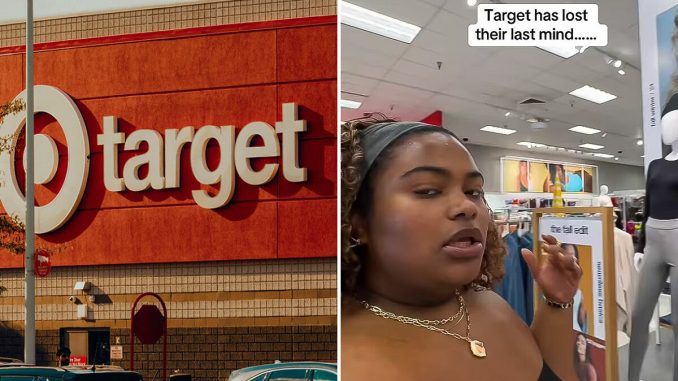
“I have a better idea. Get healthy,” reads the top comment of a viral video by a plus-sized Instagram influencer in which she attempted to shame Target for only marketing towards thin people.
The user, who goes by Samyra, recorded herself being particularly offended by a “style tip” found on a women’s jacket. “Go up a size or two on your purchase for an easy, effortlessly cool vibe,” the suggestion read.
“This is a clear example of how brands center on thinness,” the influencer argued. “How can someone who is 3X or 4X go up a size or two?”
Far from receiving a sympathetic welcome or comments of approval, Samyra got slammed on her comment section, with more than 25,000 users saying she was portraying herself as a victim and that the store had no obligation to cater to her specifically.
“Very few people are built like you. Market moves corporations, not your feelings,” one viewer wrote.
Plus-sized influencer’s attempt to shame Target for “only caring about skinny people,” backfires as netizens tell her to drop weight instead
Image credits: Shabaz Usmani
The clip begins with the influencer taking a stroll through the female clothing section of the store with the caption “Target has lost their last mind,” until she reaches the sign on which the recommendation of buying a jacket two sizes larger appears.
“Go two sizes up from an XXL?” she asked, pointing towards her own apparel size.
Image credits: samyra
Samyra then proceeds to address the store directly, saying that she’s the one who’s going to give them a “style tip.”
“If you’re going to inconsiderately suggest that people go up a size or two, at least have the sizes, and not just online, also in store,” she said, before leaving the store and demanding that the store fixes their clothing sizes, or removes the “tip.”
The clip has received an almost entirely negative response, with viewers accusing the influencer of having a “victim complex”
Image credits: samyra
A quick scroll through the comment section of her video reveals almost nothing but negative impressions, with the majority of users labeling the influencer as a “professional victim” who is, in their opinion, trying to turn a personal problem into a bigger issue.
“From a business perspective, it wouldn’t make sense to carry sizes that wouldn’t sell often,” said one user who described himself as “formerly obese.”
“People who make bad life decisions complaining about not being catered to are hilarious,” wrote another.
Despite the backlash, her video has received more than 130,000 likes, making it one of the most popular on the influencer’s page.
Retail managers explain that the issue is a natural result of supply and demand, and not an attempt to cater or discriminate a specific group of consumers based on their weight
Image credits: samyra
But how do retail stores determine the upper-size limit for clothing articles, and how do they know what quantity of each to order?
According to Ryan Hart, former Senior Inventory Planning Manager at Gap, stores use a variety of tools, including shelf solutions created by various enterprise software companies, to calculate how much specific clothing sizes sell over a period of time.
Hart explains that size is just one of many factors that are considered when calculating the stock of a certain item, and other elements such as color and branding are also important.
Image credits: samyra
“[Victoria Secret’s] Pink sells smaller sizes more often, this is a fact. Why? Because younger women buy it and are usually smaller than older women,” he said.
The manager also pointed out that buying habits often go beyond the size of the clothing article.
“Skinny jeans sell more in XL than a straight fit pair sells in XL,” he stated.
In the end, the availability of an item depends on the likelihood of it selling. In other words: supply and demand.
“There are countless ways to attribute products. Other examples of attributes [we use] are fabrications, graphics, or patterns.”
Despite being largely outnumbered, comments in favor of the influencer thanked her for talking about the issue of plus-size fashion inequities and limited options for larger customers
The overwhelming majority of comments disagreed with the influencer’s take. However, some jumped to her defense, explaining that plus-sized customers
usually face shortages on certain products, making them feel lesser than their skinnier counterparts.
“As a fat person, I have to say that most plus size stores don’t have nice clothes that I would want to wear. Simple as that,” wrote one viewer.
“If clothes are always made for skinny people, then clothes should always be made for bigger people. If nobody says anything, change won’t be made,” another added.
“Two years ago I could find sizes 26, 28 and 30 in my local Target. Yesterday I could only find up to 24,” shared one user.
It’s important to note that Target offers its own plus-size clothing section for all types of apparel found on smaller sizes.
Notorious brands include Ava & Viv, A New Day, Universal Thread, All In Motion, and Auden.
Bored Panda has reached out to store managers at Target for comment.
“The sign wasn’t for you,” wrote one user, as others joined in to criticize the influencer for her opinion
The post Influencer’s Attempt To Call Out Target For ‘Centering Thinness’ Brutally Backfires first appeared on Bored Panda.
